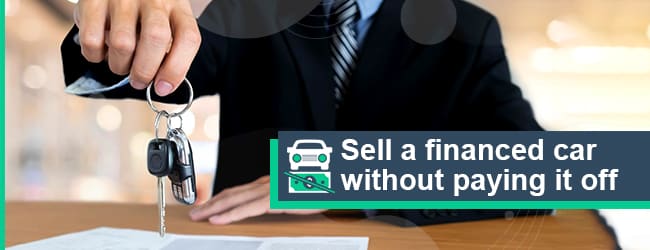Quick Answer:
To sell a financed car without paying it off, first, contact your lender to determine the payoff amount and notify them of your intent to sell.
Make sure to communicate to prospective buyers that the car is currently financed. Organize a payment method where the buyer remits the loan amount directly to the lender.
If your sale price exceeds the loan balance, arrange for the buyer to pay you the remaining amount.
Key Takeaways:
- Equity Understanding: Grasp the concept of equity in your financed car. Knowing whether you have positive equity (the car’s value is higher than the loan amount) or negative equity (owing more than the car’s worth) is vital for planning your selling strategy.
- Selling Options: Weigh your options between selling to a private buyer or a dealership. Private sales might yield more money but involve more intricacies, while dealerships offer convenience but possibly at a lower selling price.
- Paperwork Preparation: Ensure all necessary documents are in order for a smooth sale. This includes a clean Certificate of Title, Bill of Sale (if required in your state), VIN inspection, and emissions test documentation. Accurate and complete paperwork is essential for legally transferring ownership and settling the existing loan.
Know Your Loan Amount
Before initiating any sale, it’s essential to be aware of your financial obligations.
- Action: Contact your lender and inquire about the “payoff amount”, which indicates the outstanding amount on your loan.
- Example: Assume you owe $15,000 on your car loan.
Determine the Car’s Value
Understanding the market value of your car will set a benchmark for potential selling prices.
- Action: Check websites like Kelley Blue Book for an accurate market valuation.
- Example: Your car’s valuation comes to $18,000.

Calculate Equity or Negative Equity
This will determine if you stand to profit from the sale or if you’ll need to cover additional costs.
- Definition: Equity implies your car’s value surpasses your loan amount. Conversely, negative equity suggests you owe more than the car’s worth.
- Calculation: $18,000 (car value) – $15,000 (loan amount) = $3,000. Hence, you have a positive equity of $3,000.

Find a Buyer
Choosing the right buyer can affect both the selling price and the ease of the transaction.
- Options:
- Private Buyer: Potentially offers a higher price but demands more from the seller in terms of effort and paperwork.
- Dealership: Provides a straightforward process but might yield a lower price.
Handling the Transaction
Private Sale:
- Procedure:
- The buyer agrees on a price (e.g., $17,500) and pays you.
- Utilize this money to settle your loan ($15,000).
- The balance ($2,500) is your profit.
- After the loan is cleared, the lender releases the car’s lien, enabling you to transfer the title.
Dealership:
- Procedure:
- On trading in, the dealership manages the loan payment. Any equity (like $3,000) goes towards your next purchase.
- On a direct sale, the dealership might offer, say, $16,000. They settle the loan ($15,000) and pay you the difference ($1,000).

Handling Negative Equity
Being “underwater” in your loan can pose additional challenges.
- Solution: If you owe more than the market value (e.g., owe $20,000 but sell for $18,000), you must cover the $2,000 difference.
Transfer Ownership
Securing the deal legally is a crucial step.
- Action: Once the loan is settled, sign over the title. Always adhere to state-specific vehicle transfer guidelines.
Report the Sale
Keeping the authorities informed shields you from potential future liabilities.
- Advice: In numerous jurisdictions, informing the DMV or a similar entity about the sale is mandatory.
Cancel Insurance
Ensure you aren’t paying insurance on a vehicle you no longer own.
- Action: Adjust or terminate your auto insurance policy upon selling and reporting.
Keep All Documentation
Protection and clarity are paramount, especially in financial transactions.
- Recommendation: Retain copies of all transaction-related paperwork: bills of sale, transfer forms, and lender communications.
Can You Sell a Car with Negative Equity?
If you’re dealing with negative equity in your car, where the loan payoff amount exceeds the car’s value, there are several strategies you can consider:
- Pay the Difference Yourself: If it’s financially feasible, you can pay the shortfall between the car’s value and the remaining loan balance from your own funds.
- Use Sale Funds: You’ll need to pay the difference between the loan balance and the out-of-pocket sale price.
- Refinance the Loan: Consider refinancing your car loan, especially if you can obtain a lower interest rate. This can accelerate the buildup of equity by reducing the total loan cost.
How Long Does it Take for the Lender to Release the Title?
It varies, but typically, it can take anywhere from a few days to a few weeks. Check with your lender for specifics.
Can the Buyer Directly Pay Off the Remaining Loan Amount?
Yes, a buyer can directly pay off the remaining loan amount on a car. In private sales, the buyer can either pay the total sale amount to the loan servicer or pay the loan balance to the lender and the remainder to the seller.
It’s important to first contact your lender to determine the loan payoff amount and inform potential buyers about the loan. Arranging a meeting at the lending bank allows the buyer to pay off the loan and any remaining amount directly to you.
Ensure clear communication and proper handling of all paperwork during this process.
Do You Still Need to Report the Sale if You Trade a Car to a Dealership?
Yes, it’s always a good practice to report any change of vehicle ownership to avoid potential liabilities.
Reporting requirements vary by state. You must file a Report of Sale in Washington, even for trades to dealerships or private parties. In Texas, it’s advised to file a Vehicle Transfer Notification to avoid future liabilities associated with the vehicle. Always consult your state’s DMV for specific rules, as they differ across states.
What Paperwork is Required to Sell Financed Car?
To sell a financed car you will need:
- Clean Certificate of Title (required in all states)
- Bill of Sale (required in some states)
- VIN inspection (required in some states)
- Emissions test (required in some states)




